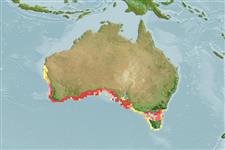Environment: milieu / climate zone / depth range / distribution range
Οικολογία
Θαλασσινό(ά) Υφαλόφιλο(α); εύρος βάθους ? - 30 m (Ref. 9563). Subtropical
Eastern Indian Ocean: Endemic to Australian waters (South Australia and Western Australia).
Μέγεθος / Βάρος / Age
Maturity: Lm ? range ? - ? cm
Max length : 75.0 cm TL αρσενικό/απροσδιόριστο; (Ref. 9563)
Found on rocky reefs (Ref. 9563). Feeds on various small fish (Ref. 2156).
Life cycle and mating behavior
Maturities | Αναπαραγωγή | Spawnings | Egg(s) | Fecundities | Προνύμφες
May, J.L. and J.G.H. Maxwell, 1986. Trawl fish from temperate waters of Australia. CSIRO Division of Fisheries Research, Tasmania. 492 p. (Ref. 9563)
IUCN Red List Status (Ref. 130435)
Threat to humans
Harmless
Human uses
αλιεία: περιορισμένης εμπορικότητας
Εργαλεία
Special reports
Download XML
Διαδικτυακές πηγές
Estimates based on models
Preferred temperature (Ref.
123201): 15.3 - 20.5, mean 17.4 °C (based on 183 cells).
Phylogenetic diversity index (Ref.
82804): PD
50 = 1.0000 [Uniqueness, from 0.5 = low to 2.0 = high].
Τροφικό Επίπεδο (Ref.
69278): 4.5 ±0.80 se; based on food items.
Ελαστικότητα (Ref.
120179): Χαμηλό, ελάχιστος χρόνος για διπλασιασμό πληθυσμού 4,5 - 14 έτη (Preliminary K or Fecundity.).
Fishing Vulnerability (Ref.
59153): Moderate to high vulnerability (50 of 100).
Nutrients (Ref.
124155): Calcium = 15.4 [8.4, 32.6] mg/100g; Iron = 0.466 [0.232, 0.847] mg/100g; Protein = 19.3 [17.5, 21.1] %; Omega3 = 0.194 [0.109, 0.341] g/100g; Selenium = 14.4 [6.3, 32.3] μg/100g; VitaminA = 92.8 [27.0, 354.4] μg/100g; Zinc = 0.574 [0.363, 0.884] mg/100g (wet weight);
